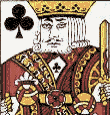 |
Progress Publishing Co. |
 |
|
A History Playing Cards |
 |
Progress Publishing Co. |
 |
|
A History Playing Cards |
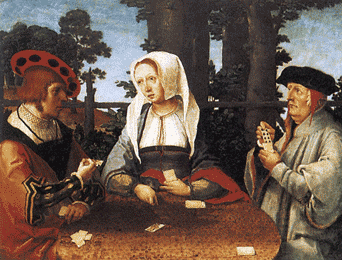
![]()

![]()
Origin, History and Evolution
of Playing Cards
*******************************************************************
Origin of playing cards
A History of playing cards in Europe
First historical references to cards in Europe
Introduction of playing cards into Europe
A History of European packs
Arrival of playing cards to America
*******************************************************************
I) Origin of Playing Cards
Due to the very long history of cards nobody knows with certainty where they originated first. Who invented them, how and under what circumstances will always remain an open question. Were they invented by one or few people or they appeared as a result of evolution of other gambling tools? – that mystery will stay unsolved. We only have few legends and few theories, but not the final answers. Due to fragility of cards there won’t be any archaeological evidence to prove or reject different theories of cards origin. There are 3 most probable birth places of playing cards – China, Korea and India (some historians add Persia).
Chinese Roots
Chinese dictionary “Ching-tsze-tung” dating from 1628 includes the legend about creation of “dotted” cards. According to it numerous members of Emperor’s army of concubines invented playing cards in a desperate attempt to break the monotony of their existence and keep themselves occupied. Dictionary specified 1120 as the year when collective concubines’ creativity came up with the idea of cards.
Early Chinese cards had resemblance with and relation to other tools and things which already existed in everyday life. Some cards resembled Chinese paper money; others were derived from dominoes or were inspired by chess.
Chinese had quite a few different packs in the different areas of the country. The difference was in the number of cards in the packs, number and type of suits and court cards. The most simple and wide-spread pack had 30 cards, 3 suits and three court cards. The suits included cash; strings and myriads. The popular court cards were red flower, white flower and thousand myriads.
Chinese cards were produced by woodblock printing on thin card board. They usually were 3.5 inches long and from one half to one and a half inches wide. Many characteristics of Chinese cards can be seen in European cards. Cards were rounded at the top and bottom and they had markings at both ends to allow a player easy recognition of a card without flipping it over. The most usual back colors were black and red.
 |
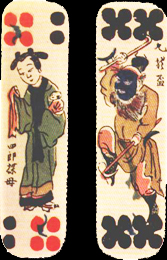 |
|
Chinese money-derived cards Source: Hargrave (1966) |
Chinese domino-based cards |
Early Korean Cards
Around 1900, Stewart Culin who was a renowned anthropologist and expert on Korean and Chinese games came to conclusion that Korean playing cards evolved from divinatory arrows. Those symbolic arrows were used in 6th century to predict future and in religious rituals. They were made from bamboo pieces.
The Korean packs had eight suites and each suit was represented by 10 cards. Nine of them were numbers from 1 to 9. The tenth and the highest card was “the general”. The suits showed man, fish, crow, pheasant, antelope, star, rabbit and horse.
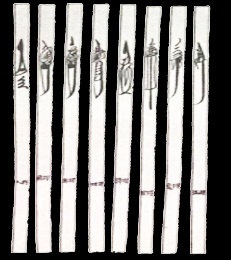 |
|
Early Korean
Cards
|
Cards in India
India has its own legend explaining the creation of cards. It’s similar to Chinese one in a way that it connects cards with royalty and female boredom in King’s boudoirs. According to Hindu legend the wife of a Maharaja was bored and irritated by her husband’s disgusting habit of constantly pulling hair from his beard. In order to keep his hands occupied and away from his beard and to entertain herself and her husband, the wife conceived the idea of the game which used cards.
Unlike the cards in China and Korea, Indian cards had a round shape. They were made of ivory, paper, wood, cotton fiber, mother of pearl and even palm leaves. Their diameter was from one and a half to four and a half inches. Cards were represented by ten suits, each composed of ten numeric and two court cards. One of the court cards of each suit illustrates one of the incarnations of God Vishnu and the second one shows a detail related to that particular incarnation. Soldiers, elephants, ships, horses, demons, women etc. can be found among the cards suits.
The earliest known to Europeans Indian card game was the game called “Ganjifa” dating to 16th century. Some historians believe that this game migrated to India from Persia even before Moslem conquest of India.
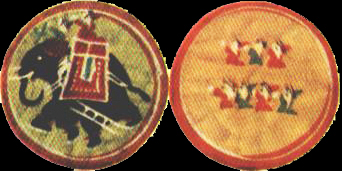 |
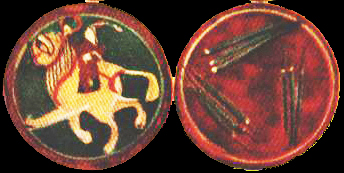 |
|
Indian round cards Source: Hargrave (1966) |
|
II) A History of playing cards in Europe
First Historical References to Playing Cards in Europe
We can say with a good deal of certainty that playing cards were not known in Europe before middle of 14th century. That certainty comes from the fact that famous writers of Pre-Renaissance era never mentioned them in their writings. Franchesco Petrach (1304 -74) and Boccacio (1313 - 75) wrote about dice and other forms of gambling but nothing was said about cards. Also, the Church ordinance dated 1363 and 1369 edict by Charles V of France prohibiting playing dice games and other games of chance did not speak of cards in any way.
First historical documents, which give a positive proof that cards spread into Europe, place that event after 1370. Most of those documents are related to prohibitions and restrictions on gambling and cards by European cities. The Law of the City of Florence dated 1376 forbade by the vote of 98 elders to 25 playing the game “naibb”, "which recently been introduced into these parts”. The modern version of the word “naibb” is Spanish “naipes”, which means “playing cards”. Similar ordinance in German city of Regensburg dated 1378 declared card games punishable by law if played for high stakes. The Chronicle of the City of Viterbo dated 1379 talks about the game of cards called” naybb”. Town ordinances of Paris (1377) and St. Gallen (1379) also outlawed card playing but only for working classes leaving it available for a high society.
By the early 15th century cards spread through most of Europe. Their popularity grew so big it provoked a reaction from Church. Monk Bernardine of Sienna preached against the evil of gambling at Bologna in 1423 so passionately, a big part of the population of the city burnt their cards in public fires. That was repeated by John Capistran in Nurenberg in 1452 and tens of thousand of dice, cards and backgammon boards were thrown into the fire.
Introduction of playing cards into Europe
There were few theories on how playing cards reached Europe.
Marco Polo Theory
According to that theory cards were brought to Europe from China thanks to Marco Polo voyages in 13th century. The fact that the earliest historical references to playing cards date at the end of 14th century makes that theory unacceptable. Besides chronological problems with that theory, the difference between Chinese cards and games of that era and European packs and games is too obvious for Chinese cards to be a direct ancestor to European cards. Also, playing cards are not mentioned in Marco Polo’s published reports of his travels “Il Milone”.
The Crusaders Theory
That theory has the same chronological problems as the previous one. It claims that Asian cards followed ancient trading “silk” routes from China through Persia and Egypt all the way to Holy Land. The Crusaders returning home after a defeat by Saladin, supposedly, brought cards with them to European cities. The last Crusade, however, was over by 1291 – almost 80 years before European cards were first mentioned by historical evidence.
The Gypsies Theory
The theory falsely stated that the playing cards were introduced into Europe by traveling gypsies. The facts are that the gypsies infiltrated Europe almost 100 years after first cards appeared in European cities.
The Mameluks of Egypt Theory
According to it the cards came from the Mameluks of Egypt. That theory is generally accepted now due to undisputed historical evidence found by L.A. Mayer. In 1939 he discovered in the Topkapi Sarayi Museum in Istanbul the complete pack of cards, which could be traced to 12th or 13th centuries. Early Italian packs of 14th century look almost identical to Mameluks pack. It consists of 52 cards of 4 suits. The suits are swords, polo-sticks, cups and coins. The cards include numerals from 1 to 10 and three courts – King, Deputy-King and Under-Deputy.
One question still remains open – did the cards enter Europe through Italy or Spain? The odds are that it happened through Italy, because cards like any other goods followed major trade routes and Venice was the main trade gate into Europe. Another argument for Italy is that early Italian pack resembles Mameluks pack a lot closer than a Spanish pack. There is still a possibility that the cards were brought to Europe first by Spanish Moors. Uncut sheet of cards dated 15th century discovered in Barcelona shows close similarity to Mameluks pack.
A History of European Packs
By the end of the 14th century playing cards spread widely across Europe and found home in Italy, Spain, Germany, France and Scandinavian countries. Since in their expansion to Europe playing cards most likely reached Italy first, the probable evolution of the European pack was: 1) Italian pack first, then 2) Spanish pack followed by 3) German and 4) French.
All European packs of the 14th century were 4-suited. They had differences in the type of suits and the number and types of court cards. There were 3 main varieties of packs: 1) Italian and Spanish, which were almost identical, 2) German and 3) French. The Tables below shows the characteristics of those packs and their differences.
| PACKS | Number of Cards |
SUITES |
COURT CARDS |
| ITALIAN | Usually 52 or less | Cups – analogous to our Hearts; Swords – analogous to Spades; Money – Diamonds; Batons - Clubs |
4 Cards: King; Queen; Knight; Servant (Jack)
|
| SPANISH | 48 or less | Cups; Swords; Money; Clubs |
3 Cards: King; Knight; Deputy (Jack); (Queen is absent)
|
| GERMAN | 48 or less |
Hearts; Acorns – Spades; Bells – Diamonds; Leaves - Clubs
|
3 Court Cards: King; Ober-Knecht (Upper Servant); Under-Knecht (under servant); (No Queen in the Pack)
|
| FRENCH | 52 or less |
Hearts; A Pike – Spades; A Paving Tile – Diamonds; A Clover Leaf - Clubs
|
4 Cards: King; Queen; Knight; “Valet” (Jack)
|
|
PACKS |
SUITES |
|||
|
Italian |
|
|
|
|
|
Spanish |
|
|
|
|
|
German |
|
|
|
|
|
French |
 |
 |
 |
 |
French Pack introduced major changes that simplified the pack and its production. Four suits were divided in two black suited and two red ones. Previously, suits came in 4 colors – black, red, blue and green. The suits markings (“pips”) were made smaller and their shape was simplified. In result the production of the cards became cheaper and faster and by 15th century France turned into Europe’s leading manufacturer of playing cards. French cards were exported to England, Italy, Spain, Switzerland and other countries.
French suits, which eventually were accepted by other card-playing nations, represented 4 classes of medieval French society. Hearts symbolized the Church, the pikes (spades) represented the military, a paving tile (diamond) was the symbol of the merchant class and a clover leaf (clubs) stood for farmers.
The first playing cards were imported into England in early 15th century. The packs had Italian-Spanish and French design. English card makers started manufacturing cards around 1450. They copied French design and introduced the custom of making cards recognizable from both ends. Later on English started the custom of decorating the ace of spades and that’s why “the ace of spades is the most beautiful card in the deck”. That custom originates from a tax levied by British government on every deck. The ace of spades was taken from the deck to the tax office to get a tax stamp. Eventually the stamp was placed on the package, but the additional decoration (resembling the stamp) survived on the ace of spades.
III) Arival of Playing Cards to America
There is no question that the first playing cards came to America with Spaniards. It was possible to find in the 20th century among the Indians of American Southwest the cards made of deer and ship skin with the design similar to old Spanish Cards of 16th century. Many cards used by Indians shared with Spanish cards the same names for court cards and suits. The History of Florida published in Madrid in 1723 mentions the fact that soldiers of Spanish expedition played the cards made of leather.
There is a legend saying that sailors in Columbus voyage were forced by their superstition to throw cards overboard to stop the storms and bad weather in dangerous seas. When they finally arrived to the New World they made new cards out of the leaves of the copas trees.
European colonists brought with them playing cards they enjoyed in their old countries. English brought them to Virginia, Spanish to Florida and the Dutch to New Amsterdam. The cards even invaded Puritan New England, which is proved by a Plymouth Colony record of 1633 saying that few persons were fined for playing cards. In 1656 Pilgrims enacted the Law, which fined adults for playing cards and even subjected children to a public whipping for a second offence. The biggest fine for students in Harvard University was not for fighting or drinking but for playing cards.
Many Founding Fathers including Washington, Jefferson and Franklin were enthusiastic card players.
Copyright 2006 Progress Publishing Co.
Selected References:
| Ed. S. Taylor The History of Playing Cards | Catherine P. Hargrave A History of Playing Cards |
| W.G Benham. Playing Cards/The History and Secrets of the Pack | Roger Tilley A History of Playing Cards |
| David Parlett The Oxford Guide to Card Games | David G. Schwartz The History of Gambling /Roll the Bones |
| Henry Chafets Play the Devil /A History of Gambling in USA | Frederique Crestin-Billet Collectible Playing Cards |
| Henry Renee D'Alemagne Antique Playing Card Designs | Alice Fleming History of Gambling |